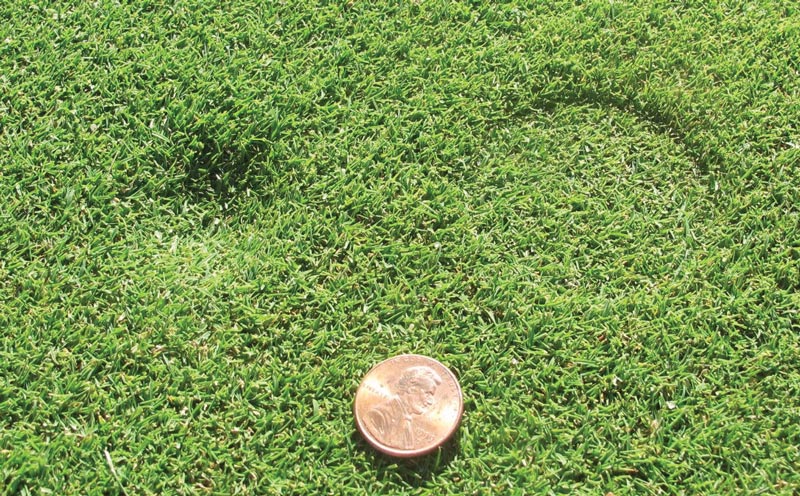
Figure 1. Impressions made on a putting green surface by the TruFirm Turf Firmness Meter (left) and the Clegg Impact Soil Tester during the measurement process. Photos by Daniel O’Brien
We’ve been extremely fortunate to work with a lot of neat “gadgets and gizmos” during our research, taking all types of measurements, usually on putting greens. We’ve collected a lot of interesting data and learned quite a bit along the way, but we must confess that when it comes to firmness, we still have a lot of questions. We’ll work our way back to those, but let’s start with the basics of what we do know.
Putting green firmness: Important and elusive
In and of itself, firmness isn’t a difficult concept to understand or appreciate. After all, it’s one half of the celebrated mantra of “firm and fast,” it has direct implications on playability, and the overwhelming consensus is that it’s a desirable attribute of a quality golf course. We care about firmness because it relates to ball-bounce and shot-hold capacity and the durability of the putting surface. When managed properly, firmness can be a defining hallmark of the skill and strategy required to play the game at the highest level.
But where the waters become a little murky is when you try to articulate what ideal firmness looks like. We often talk about firmness not so much by what it is, but by its absence — “These greens are too soft/too hard.” Ultimately, firmness is about rewarding (and demanding) quality golf shots while preserving the integrity of the putting surface.
The key point in all of this is, with firmness, sometimes it’s easier to attach a number than a definition. With technology today, we can measure a lot of things, but firmness measurements on their own are just a number. If you’re going to spend the time collecting those numbers, you need to have a picture of what that number looks like at the moment of impact when the golf ball meets the putting surface.
Tools for measuring putting green firmness
When it comes to producing a number you can work with, there are several options for how to do it. We’re going to separate those options into two basic camps: accelerometer measurements and depth measurements (Figures 1 and 2). There is a third “indirect” option for assessing firmness through volumetric water content (VWC), which we’ll touch on as well.
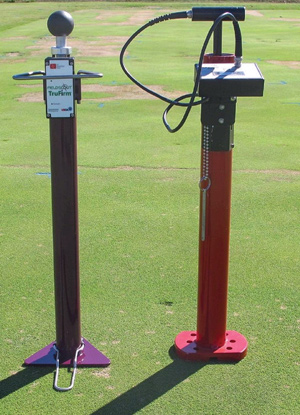
Right: Figure 2. Firmness meters such as the TruFirm Turf Firmness Meter (left) and the Clegg Impact Soil Tester use a free-falling impact hammer to measure surface firmness of turfgrass surfaces. The TruFirm directly measures penetrating depth of the hammer into the turf, while the Clegg uses an accelerometer to measure the deceleration upon impact.
Starting with accelerometer measurements, the Clegg Impact Soil Tester is the standard in turfgrass research. Originally developed by Baden Clegg, Ph.D., for testing road subgrades (1), this device has proven particularly useful for evaluating the hardness (or softness) of turfgrass surfaces. The accelerometer is contained within a weighted cylinder (aka impact hammer), which is raised to a prescribed height and dropped through a guide tube, and upon impact with the ground, everything comes to an abrupt stop. The deceleration caused by that collision with the ground is recorded through electrical impulses and reported in units of gravities (G) (7). While these units are not something most of us encounter on a daily basis, the take-home message is, the larger the number, the firmer the surface.
It is important to note that there are different models and protocols for the Clegg. Different models have different hammer weights, and protocol differences typically involve variations in the height from which the hammer is dropped or the number of drops in a single location before the value is recorded. If you’re trying to compare your measurements to a reference dataset or a range of values, be sure you know the model and protocol used. The American Society for Testing Materials (ASTM) is a good source for more details on specific testing protocols. For turfgrass situations, the 2.25-kilogram model is very common, as is a single hammer drop per location (a 0.5-kilogram model is also available). At the time this article was written, a 2.25-kilogram Clegg could be found for around $4,500.
When it comes to depth measurements, the TruFirm Turf Firmness Meter from Spectrum Technologies is similar to the Clegg in appearance, but it does not contain an accelerometer. There was an original version of the TruFirm developed by the USGA’s Matt Pringle, Ph.D., for use by USGA agronomists that did utilize an accelerometer. Spectrum Technologies’ adapted version replaced the accelerometer with what it calls a “rotary position sensor” (6).
The TruFirm’s impact hammer has a dome-shaped end to mimic a golf ball, and upon contact with the ground, the dome’s maximum depth of penetration is what is reported in inches. Other devices, such as the Precision Putting Green Digital Firmness Meter (Precision USA), create a similar measurement by dropping a weighted ball from a standard height and measuring the indention in the green with a digital depth gauge. We’ve even seen videos online of DIY versions replicating this technique with an Accugauge and bedknife. Whichever device is used, it is the deformation of the putting surface that is effectively being measured, so that the larger the number, the softer the surface.
Current prices for the Spectrum TruFirm and Precision USA Firmness Meter come in at just under $950 and $600, respectively.
On a related note, if you’re interested in firmness of bunkers or fairways or measuring compaction farther down beneath the surface, you may want to consider an additional category of devices known as penetrometers. Penetrometers measure the resistance of the soil when a probe is pushed in with steady force, but their use on putting greens is not as common as the previously mentioned devices.
Editor’s note: Find all past installments of “What the Tech?” and other insights on using technology in golf course management — from robotic mowers to drones to smartphone apps — at GCMOnline.com/Tech.
Putting green firmness and moisture
This is the place to mention something that you already know intuitively: There is a meaningful relationship between putting green firmness and moisture content, and, typically, wetter greens tend to be softer (4, 5). With the prevalence and versatility of today’s portable moisture meters capable of measuring VWC within 0.5 inches (1.27 centimeters) on the putting surface (Figures 3 and 4, below), moisture meters are definitely a part of the firmness measurement conversation (3). (For much more on moisture meters, see What the Tech? Moisture meters for greater efficiency, healthier turf.)
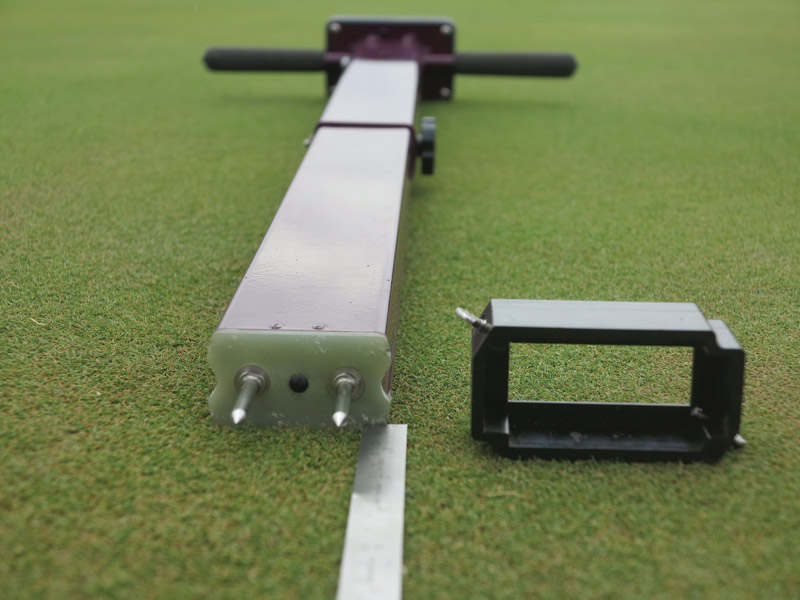
Figure 3. Portable soil moisture meters such as the TDR 350 (Spectrum Technologies Inc.) are capable of estimating volumetric water content (VWC) close to the putting surface using short (“Turf”) rods and a spacer block.
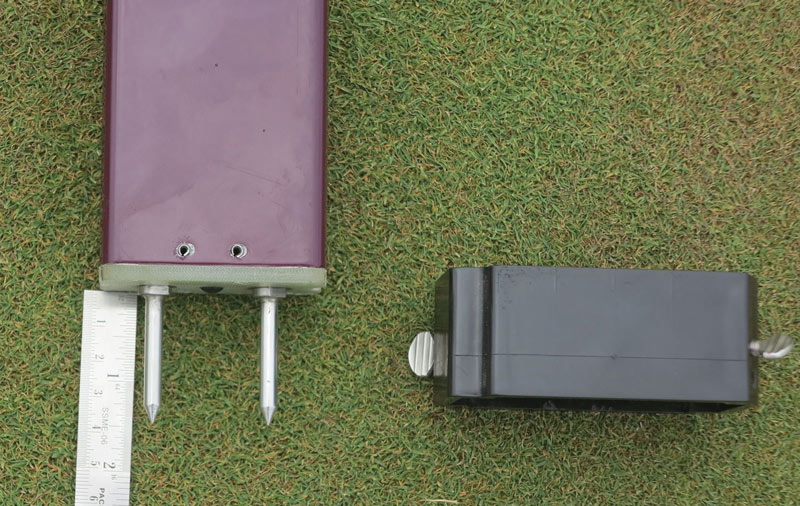
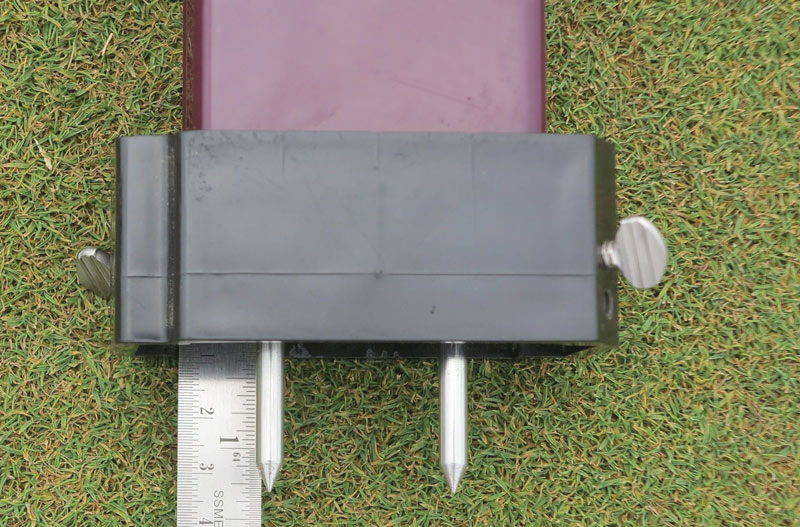
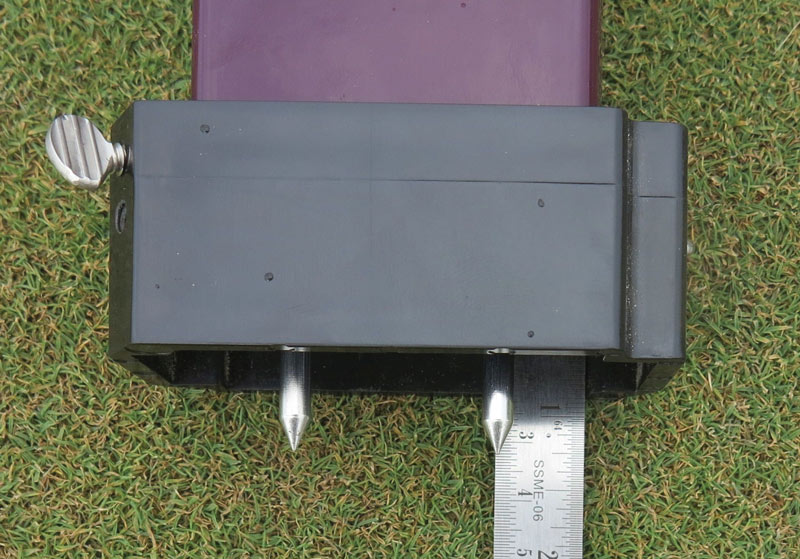
Figure 4. Turf rods on their own measure to a depth of 1.5 inches (3.81 centimeters) (top), and when used with a spacer block, measurements can be made at 1.0 inches (2.54 centimeters) (middle) and 0.5 inches (1.27 centimeters) (bottom).
That brings us full circle to our lingering questions, the first one being, if you’re already using a moisture meter on your greens, how much do you consider the firmness measurement to be redundant as opposed to unique information?
There is a relationship between moisture and firmness, but what is the extent of that relationship? If the moisture meter reading is on the dry side, but the firmness meter gives you a number you consider soft, how do you balance those two pieces of information and translate them into specific cultural management practices? All of this leads to another, broader question: What else, in addition to moisture, is reflected in a firmness measurement?
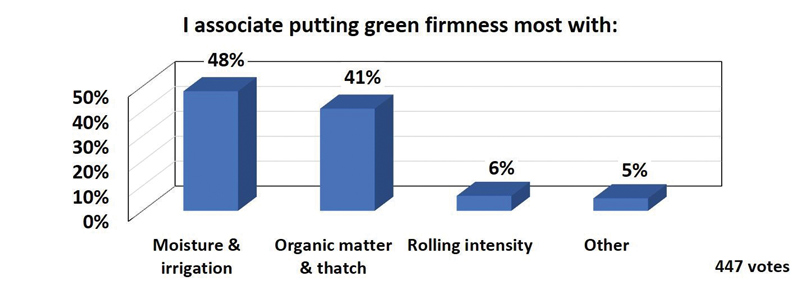
Figure 5. Results of a Twitter poll conducted by Mike Richardson, Ph.D., gauging perceptions regarding putting green firmness.
Several years back, we put out a Twitter poll that some of you may have participated in, asking about perceptions related to putting green firmness (Figure 5). Moisture was No. 1, followed pretty closely by organic matter and thatch, with rolling intensity a distant third. For the record, there is probably not a single right answer, as they can all play a role. But even more, firmness meters can be excellent tools to assess how different cultural practices alter firmness, not so much by measuring firmness as by measuring the change in firmness.
If you measure firmness before and after rolling, topdressing, aerification, applying a wetting agent, etc., and quantify the change in firmness each of those practices brings about, then you’ve really refined (and expanded) the tools available to you for managing firmness. Irrigation and evapotranspiration could certainly be included as well to help predict the response of firmness to changes in VWC throughout the day. Ultimately, you’re creating a strategic arsenal for managing firmness in a more comprehensive way — not just managing the moisture, but giving yourself an opportunity to manage all the factors that may influence firmness.
Finally, it’s worth asking whether you’re measuring firmness in order to hit a specific benchmark number, or is it about monitoring consistency across all greens? Consistency is especially interesting, because it leads to other questions, such as how much putting green size, slope and hole length should factor in when attempting to optimize firmness. If you have a short par 3 with a large, flat green where players are lobbing in high-arching shots with lots of spin, and you have a long par 4 with a small, undulating green that receives a lot of low-trajectory, long-iron approach shots, how important (and appropriate) is it for the firmness measurements of those two greens to be the same number?
Admittedly, there is a reluctance in asking these questions, as if it’s sacrilege to the Stimpmeter way of thinking, where consistency is paramount. But the more we work with firmness meters, the easier it is to appreciate the fundamental differences between the information they give us and what a Stimpmeter provides. Consistency makes a ton of sense for green speed because there is so much consistency with the type of shots most affected by it, i.e., putts. But there can be so much variability in the types of shots landing on greens, it’s fair to wonder whether we are becoming too beholden to a firmness number just because we can measure it.
For those of you currently using firmness meters, practically speaking, how different do firmness measurements have to be before it makes a difference in what you see when a ball lands on your greens? Just because two numbers are statistically different doesn’t necessarily mean they are appreciably different in terms of ball bounce and putting green damage. (See Golfers’ perceptions of greens speeds vary from the March 2001 issue of GCM for a great discussion of golfers’ perceptions related to changes in putting green conditions [2]).
The bottom line is, it all comes back to matching firmness measurements with what you see happening with your own eyes as shots land, and determining what you consider the ground-truth data for firmness measurements to be.
Real-world applications
One of the best lines regarding all the technology, measurement and equipment stuff we write about in “What the Tech?” came from one of our own, Mike Richardson, Ph.D., as we prepared for our “Gadgets and Gizmos” seminar at the Golf Industry Show. “You have to remember,” he said, “in our research, we use all of these devices for documenting, but the superintendents we’re speaking to have to use them for decision-making.” And while we’ve always tried to appreciate that important distinction, firmness is definitely the most difficult one to grasp from the decision-making side of the coin.
If there’s anyone out there who wants to talk firmness, please drop us a line. We’ll continue to study firmness, but for that research to be truly meaningful, it needs to be meaningful to you. Ultimately, turfgrass research needs to better understand how a firmness measurement might change the way you manage your greens — if it leads you to do something different than you otherwise would have without it.
Literature cited
- Clegg, B. 1976. An impact testing device for in situ base course evaluation. Australian Road Research Board Conference Proc 8(8).
- Karcher, D., T. Nikolai and R. Calhoun. 2001. Golfers’ perceptions of greens speeds vary. Golf Course Management 69(3):57-60.
- Karcher, D., M. Richardson and D. O’Brien. 2019. Use moisture meters for greater efficiency and healthier turf. Golf Course Management 87(7):40, 42, 44, 46.
- Linde, D.T., L.J. Stowell, W. Gelernter and K. McAuliffe. 2011. Monitoring and managing putting green firmness on golf courses. Applied Turfgrass Science 8(1):1-9.
- Stowell, L J., P. Gross, W. Gelernter and M. Burchfield. 2009. Measuring greens firmness using the USGA TruFirm and the Clegg Soil Impact Tester at Victoria Country Club: A preliminary study. Online. PACE Turf Super Journal. PACE Turf LLC, San Diego (https://www.paceturf.org/PTRI/Documents/0901_sj.pdf).
- Spectrum Technologies Inc. 2013. FieldScout TruFirm Turf Firmness Meter product manual, Item Nos. 6490, 6490B and 6491. Spectrum Technologies, Aurora, Ill.
- Thoms, A.W., J.T. Brosnan, J.C. Sorochan and A.M. Saxton. 2016. Exploring relationships in surface-hardness data collected with different instruments. Journal of Testing and Evaluation 44(2):945-951.
Daniel O’Brien is a former program technician and current Ph.D. student, Doug Karcher is a turfgrass soil specialist and professor, and Mike Richardson is a professor in the Department of Horticulture at the University of Arkansas, Fayetteville.